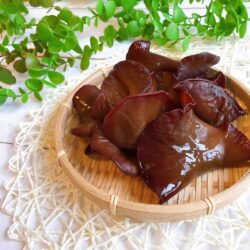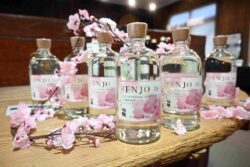Gold-Knot / Gold Leaf Jewelry Turns Kanazawa Craft into Fashion Statement

Gold leaf jewelry by Gold-Knot
8:00 JST, January 1, 2023
Necklaces, earrings, and brooches covered with gold leaf shine with a delicate luster inside a Kanazawa jewelry shop. Gold-Knot, an accessory brand from the city, offers unique gold leaf pieces that combine Kanazawa’s traditional gold leaf crafting with local silk thread. When you hold the pieces in your hand, they are so light as to almost be weightless. They rest glamorously on your clothes, which neither sag nor lose shape under the adornments. And the price tags are reasonable as well. Gold leaf in Japan is almost all produced in Kanazawa. However, the industry is suffering from shrinking demand and unprecedentedly high gold prices. Gold leaf jewelry is a new art that has made waves in this world of tradition, and it is drawing attention abroad as well.
-

Exterior view of Gold-Knot
-

Inside the Gold-Knot store, where many gold leaf accessories are displayed for sale
-

The sign for Gold-Knot
-

Entrance to Kanazawa Station
-

Hyakumangoku-dori Street in front of the store. On the other side of the street is a tourist information center.
I visited Kanazawa to immerse myself in the dazzling world of gold leaf. Upon exiting the Hokuriku Shinkansen “Kagayaki” train, I was greeted by Shinji Kamoya. He was wearing a hat with a gold leaf brooch attached to it, which suited him quite well. Kamoya, born and raised in Kanazawa, is the producer for Gold-Knot. He and designer Satomi Kiwada, both 58, run H2O, the company that manufactures and sells the brand’s merchandise. Upon entering the brand’s store, which also serves as a workshop and is located on Hyakumangoku-dori, a historic main street equivalent to Ginza’s Chuo-dori in Tokyo, I was enveloped by the elegant glow of the gold leaf jewelry that filled the display cases and covered the walls.
-

Gold-Knot’s Shinji Kamoya, right, and Satomi Kiwada
-

Pendants of various designs. The silver-colored pendant, right, is coated in platinum leaf.
-
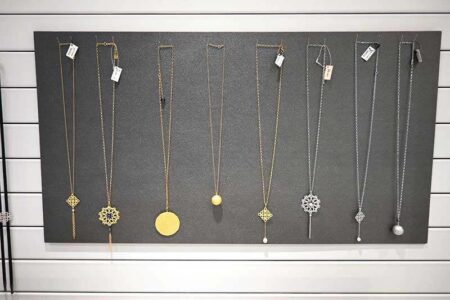
More pendants, with the three silver-colored pendants, right, being platinum coated
-

Pendants of various designs
-

Gold leaf jewelry on display in the store
“The jewelry is made by applying layers of gold leaf to tatted lace, which is believed to have originated in Europe in the 16th century, using a unique patented technique. Everything is handmade,” explains Kamoya. Within the store’s workshop area, Kiwada and two other staff members were hard at work, such as applying gold leaf to silk thread lace.
-

“Dance of Leaves” brooches, selected to be a Good Ishikawa Brand product
-

A certificate showing that “Dance of Leaves” brooches are a Good Ishikawa Brand product
The production process begins with hand knitting lace designed by Kiwada, using local silk thread from Komatsu, Ishikawa Prefecture. Then, Kanazawa gold leaves as thin as 1/10,000th of a millimeter are applied to the lace. The gold leaf is so fine that the slightest breeze can lift it and carry it away. The company’s patented technique is used to fix the gold leaf to even the smallest details of the weave. The excess gold leaf is then brushed off, and the lace is assembled into necklaces, earrings and other accessories.
Born of a hobby
-

Kiwada tatting lace (Courtesy of Shinji Kamoya)
-

Removing excess gold leaf with a brush (Courtesy of Shinji Kamoya)
-

Many customers buy the accessories not only for themselves but also as gifts.
Gold-Knot, which promotes “wearing traditional crafts in daily life,” stands out for how it combines gold leaf and silk thread and Japanese and European techniques. It all started when Kiwada, who says she has knitted since she was a child, came across European tatted lace through various knitted pieces. “It is a delicate and sophisticated lace that can express diverse patterns with knots of thread,” says Kiwada. “I thought that, with this lace, I could make accessories that even someone like myself who is allergic to metals could wear.”
Kiwada, a former designer for a local tableware manufacturer, was inspired to create her own unique products. She studied tatting through books and the internet, learned from an instructor, and at first tried to make pieces using only thread. However, they lacked a sense of splendor, and it was also difficult to make them durable. Then, she came up with the idea of applying Kanazawa’s traditional gold leaf. “I am not allergic to gold leaf. I thought it would be the best material because it provides both brilliance and strength,” recalls Kiwada. She thought that thin silk threads would go well with the delicate shine of Kanazawa gold leaf, and so she decided these would be her materials.
-

Kiwada applies gold leaf to lace. The box in the foreground holds leftover gold leaf that has been brushed off.
-

Kiwada carefully applying gold leaf
-

Kiwada applying gold leaf to lace
-

Kiwada applying gold leaf to lace. The box in the foreground holds leftover gold leaf that has been brushed off.
However, it was not easy to neatly apply the ultra-thin Kanazawa gold leaf to the lace with its complicated patterns. Moreover, if the gold leaf were to peel off easily, the product would not be marketable. When she asked a manufacturer of gold leaf-based products, she was told that they had no experience in applying gold leaf to thread, and that their prototypes were not satisfactory. So she decided to take matters into her own hands and consulted with the Industrial Research Institute of Ishikawa. One year later, in 2014, the necessary technique was established, and her jewelry went on sale. The technique was patented in 2019.

Kiwada smiles with confidence. “I want people to wear the pieces every day, not just on special occasions,” she says. “If they get stained, you can reapply gold leaf. They can be put in an ultrasonic cleaner for eyeglasses. Even if they are washed in the washing machine by mistake, they will be fine. If they lose their shape, just iron them and they will return to their original form.”
Traditional entsuke gold leaf
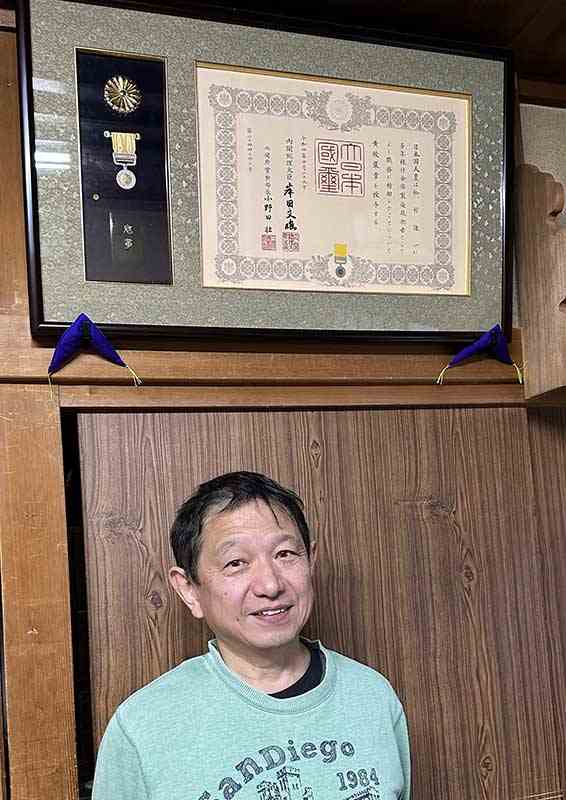
What exactly is Kanazawa gold leaf, which accounts for 99% of all gold leaf in Japan? I visited the home of Kenichi Matsumura, 62, a gold leaf craftsman who is keeping alive the art’s traditional entsuke technique, in Kanazawa City.
“It takes three or four years to learn the whole process. From there, it takes five to ten years to become a full-fledged gold leaf craftsman,” said Matsumura, relaxed and smiling. When I entered the room off the entrance of the house, I found four people working there: Matsumura, his wife, his son, who will succeed him, and a female trainee, all going about their own work. Above the lintel of a doorway was a plaque bearing a Medal with Yellow Ribbon, awarded last year to Matsumura by the Emperor in recognition of his many years of achievement as a gold leaf craftsman.
Besides the entsuke process, which is time-consuming and labor-intensive, there is also a simplified process called “tachikiri,” and this is currently the most common method of gold leaf production. Entsuke gold leaf is mainly used for the restoration of national treasures and cultural assets such as Nikko Toshogu shrine in Tochigi Prefecture, and was registered as one of the “traditional skills, techniques and knowledge for the conservation and transmission of wooden architecture in Japan” on UNESCO’s Intangible Cultural Heritage of Humanity list in 2020.
-

A certificate of UNESCO’s recognition of traditional techniques related to wooden architecture as Intangible Cultural Heritage in 2020, at an exhibit of the leaf industry cooperative association
-

Gold leaf used at Nikko Toshogu shrine, at an exhibit of the leaf industry cooperative association
“Making gold leaf means making paper,” Matsumura said. To make the gold leaf fine, craftsmen beat the metal sheets, but not directly. The still-thick gold leaf is sandwiched between sheets of a special handmade Japanese paper called “hakuuchi-gami” paper. A stack formed of the gold leaf and paper is then bound together and beaten, eventually stretching the gold till it is as thin as 1/10,000th of a millimeter in thickness. This would be like stretching gold equivalent to the size of a 10-yen coin to the size of four tatami mats.
Making such hakuuchi-gami paper is the cornerstone of entsuke, and it is a slow process that requires the passion and dedication of a craftsman. As a first step, paper craftsmen prepare gampi paper by boiling the bark of the gampi, a deciduous shrub in the Mezereum family, in rice straw lye and mixing it with a special mud. The gold leaf craftsman’s work starts here, making hakuuchi-gami paper using unique methods such as adding persimmons and chicken eggs to gampi paper. This process takes three to six months to complete, depending on the craftsman. Incidentally, pieces of hakuuchi-gami that have already been used dozens of times and fulfilled their main purpose are reused by geigi, or geisha, in Kanazawa as oil-absorbent paper. This, I thought, was a wonderful, environmentally friendly way to make use of the wastepaper.
Traditional skills in crisis
-

Gold leaves are quickly placed one by one between sheets of hakuuchi-gami paper at Kenichi Matsumura’s workshop.
-

Gold leaves are quickly placed one by one between sheets of hakuuchi-gami paper at Kenichi Matsumura’s workshop.
-
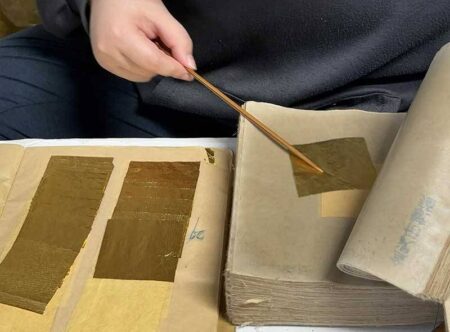
Gold leaves are quickly placed one by one between sheets of hakuuchi-gami paper at Kenichi Matsumura’s workshop.
-

Cleaning used hakuuchi-gami paper
There are currently no more than 20 entsuke craftsmen stubbornly carrying on the tradition. The decline of the field is not only due to the rise of the less expensive tachikiri, which uses machine-produced glassine paper coated in carbon and aims for efficiency. The nationwide drop in demand for butsudan, or Buddhist altars, has had a major impact, while the Great Recession of the Heisei era and the soaring price of gold, which is going for more than ¥8,000 per gram, have only further exacerbated the situation.
Matsumura, who also serves as chairman of the Kanazawa Gold Leaf Traditional Technology Preservation Association, says, “What I am concerned about now is the closure of temples.” An increasing number of temples that have been regularly restored with entsuke gold leaf are finding it difficult to even maintain their temples due to a decrease in the number of danka, or parishioners.
Where is the way forward? If we look overseas, we can find gold leaf being used in Europe, the United States and the Middle East. However, penetrating such markets seems a difficult task. While such countries like their gold leaf shiny, Japanese gold leaf has a gentle luster. And in contrast to thicker foreign products, the ultra-thin Kanazawa gold leaf is not suitable for the exteriors of large buildings. At the same time, however, these attributes are also Japan’s strengths.
-

A ritual that recreates how gold leaves were beaten by hand with a hammer (Courtesy of Shinji Kamoya)
-

Hammers once used to beat gold leaf, at an exhibit of the leaf industry cooperative association
-

Edo period documents related to gold leaf production, at an exhibit of the leaf industry cooperative association
Matsumura believes that in order to make the world aware of the appeal of Japanese gold leaf, the skills and history of the craft must first be compiled and preserved for the next generation, and he is trying to compile documents as he interviews people. “Nowadays gold leaf is stretched by machine, but in the Edo period, it was made by hand,” Matsumura says. “That is amazing. I want to start by learning the foundations of these skills.”
A history tied to the Kaga Clan

At the Kanazawa Yasue Gold Leaf Museum, which tells the history of Kanazawa gold leaf, I was surprised to learn that the screen in an exhibition room showing a video was made of gold leaf. This is a gorgeous production that is unique to the museum.
The museum was opened in 1974 by Takaaki Yasue (1898-1997), a gold leaf craftsman who invested his own money to open the museum in order to “leave the pride of gold leaf craftsmen and the proof of their abilities to future generations.” The museum’s operations were later assumed by Kanazawa City and its location moved to its current spot in the Higashiyama district about 10 years ago. The nearby Higashi Chaya-gai district is a tourist attraction that features charming cobblestone streets and historic buildings with beautiful wooden latticework. The area was once the workplace of many gold leaf craftsmen, who in their more prosperous days enjoyed the company of geisha.
-

The Kanazawa Yasue Gold Leaf Museum, which introduces the history of gold leaf
-

A gilt phonograph on display in the museum
“[Kaga Clan founder] Maeda Toshiie, was in Kyushu during Toyotomi Hideyoshi’s war against Korea.” Akitaka Kawakami, director of the museum and professor emeritus at Kanazawa College of Art, explained the history of gold leaf as he guided me through the museum. “In 1593, a letter was sent home from the camp, ordering gold leaf to be made in Nanao and silver leaf to be made in Kanazawa.”
Gold leaf has a long history in Japan. The Italian traveler Marco Polo introduced Japan as “Zipangu, the land of gold” in his travelogue “The Travels of Marco Polo,” which recounts his tour of Asia in the latter half of the 13th century. Gold leaf was used in the Konjikido hall of Chuson-ji temple in Hiraizumi during the Heian period and in Kinkaku-ji temple in Kyoto during the Muromachi period. The Kaga Clan’s gold leaf was struck a little later, around the end of the 16th century.
Why did gold leaf flourish in Kanazawa and why did it remain contained to the city? “It’s probably because Kanazawa is blessed with favorable conditions, such as good quality water, which is necessary for making hakuuchi-gami paper, and relatively high humidity throughout the year, which prevents static electricity,” Kawakami explained. Amid this environment, the Kaga Clan, with its promotion of a unique world of arts and crafts, laid the foundations for the traditions that continue to this day.
Repeated hardships
-

Finished gold leaf, left, on display at the museum
-

Thick gold leaf before beating, on display at the museum
At the museum, I learned that the Kanazawa gold leaf industry has overcome many ordeals over the ages. Rather than one technique being passed down through the generations for 400 years, I got the impression that the chain of artisans was repeatedly broken off and then restarted.
The first challenge came when the Edo shogunate banned the manufacture of gold and silver leaf. During this period, the Kaga Clan managed to survive by calling in craftsmen from Kyoto, which was under the direct control of the Tokugawa Shogunate. Kanazawa gold leaf flourished in the Meiji period (1868-1912), and in the Taisho period (1912-1926), craftsmen in Kanazawa developed an electrically powered machine to beat the leaf, replacing the conventional hammering that craftsmen had formerly done by hand. Efficiency improved and production volume increased.
-

An electric leaf beating machine invented in the Taisho era, on display at the museum
-

Buddhist altars richly decorated with gold leaf, on display at the museum
However, war in the Showa period (1926-1989) brought hardship once again. Luxury goods were banned and the industry was devastated. During the conflicts, craftsmen were gathered from all over the country and used electric leaf-punching machines to produce aluminum leaf for aircraft parts and other products. Then, after the war, the industry recovered from its nadir. Riding the wave of economic growth launched by the Korean War and the rapid economic expansion that followed, production steadily increased until the collapse of the bubble economy in 1989. The current post-bubble period can be described as the third period of hardship.
-

A display showing color differences between different grades of gold leaf, at an exhibit of the leaf industry cooperative association
-

Various metal leaves, at an exhibit of the leaf industry cooperative association
-

Gold leaves are not made by beating pure gold, but rather alloys that contain a little silver or copper to adjust the color or improve the metal’s ability to stretch. Depending on their percentage of gold, the leaves are sorted into different grades. (Exhibit of the leaf industry cooperative association)
-
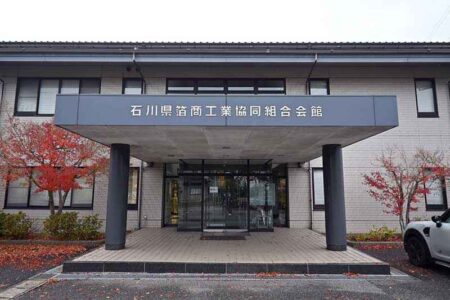
Ishikawa Prefecture leaf industry cooperative association building
According to Naohisa Yamaga, secretary general of the Ishikawa Prefecture leaf industry cooperative association, the most active year for gold, silver and platinum leaf production was 1990, just after the collapse of the bubble economy, when total production value hit an estimated ¥13.6 billion. Today, that number has dropped to ¥1.5 billion, just above 10% of the 1990 level.
The good news is that Ishikawa Prefecture will begin restoration work on the Ninomaru Palace at Kanazawa Castle as early as fiscal 2024. Locals expect the palace will be decorated with entsuke gold leaf.
Wings spread to the world
-

Kanazawa Castle Park during cherry blossom season (Courtesy of Shinji Kamoya)
-
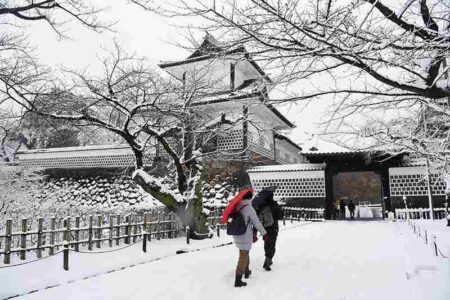
Kanazawa Castle Park after a snowfall in December 2022 (Courtesy of Shinji Kamoya)
-

Oyama Shrine, located near the Gold-Knot store (Courtesy of Shinji Kamoya)
“I traveled all over the country, from Hokkaido in the north to Okinawa in the south,” said Gold-Knot’s Kamoya. He has traveled all over Japan, setting up booths in department stores and event venues to sell accessories at special exhibitions featuring products from Ishikawa Prefecture or Kanazawa City. As a result of these efforts, a growing number of fans have come to visit the store when they are in Kanazawa on vacation. This is one reason why he moved the store and workshop from a back street to its current location on the main street in January 2022. The accessories mainly go for between ¥20,000 to ¥40,000, making them obtainable for many people. There are also slightly more expensive items made with traditional entsuke gold leaf. During my interview, a constant stream of customers came through the shop’s doors.
New sales channels are also being opened in the United States. When Kamoya and Kiwada went to a product exhibition held in the U.S., they caught the eye of attending buyers, and in 2019, sales began at the Museum of Arts and Design in New York City. On the U.S. West Coast, they also delivered products to the J. Paul Getty Museum in Los Angeles and the Portland Japanese Garden, which was recently expanded by architect Kengo Kuma.
Kamoya and Kiwada embrace a dream of spreading Kanazawa’s traditions to the world in a new form. And now this dream of theirs is winging to new heights.

Gold-Knot
5-6 Minami-cho, Kanazawa City. The store is located on Hyakumangoku-dori Street and close to the Oyama Shrine Gate. Open from 11:00 a.m. to 6:00 p.m. Closed on Wednesdays and the second Sunday of the month. For more information, please visit the brand’s website (https://gold-knot.com/ ).
Japanese version
"JN Specialities" POPULAR ARTICLE
-

Disaster Preparedness / Apartment Management Associations: Instructions on What to Do in the Event of Power Outage
-

Kawasaki Releases Guide to Sheltering at Home During Disasters, with Essential Tips for Apartment Residents
-

The Japan News / Weekly Edition (12/19-12/25)
-

The Japan News / Weekly Edition (12/26-1/1)
-

Mt. Oyama Offers Historical Site Filled with Nature, Spirituality
JN ACCESS RANKING
-

As Chinese Tourists Shun Japan, Hotels and Stores Suffer
-

Tokyo Economic Security Forum to Hold Inaugural Meeting Amid Tense Global Environment
-

Osaka-Kansai Expo’s Economic Impact Estimated at ¥3.6 Trillion, Takes Actual Visitor Numbers into Account
-

BOJ Gov. Ueda: Highly Likely Mechanism for Rising Wages, Prices Will Be Maintained
-

Japan Govt Adopts Measures to Curb Mega Solar Power Plant Projects Amid Environmental Concerns




